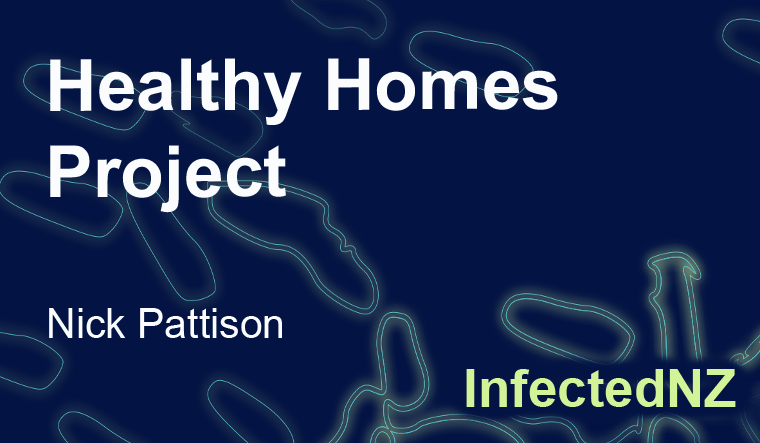My name is Nick Pattison and I would like to share with you a citizen science investigation that I was involved in with my previous school Rongomai Primary, called the Healthy Homes Project. The project was created out of conversations between myself and other community members in Otara about the state of local housing in South Auckland, and was magnified at the time by the death of a two-year-old girl in Otara with poor health conditions linked to her damp state home. Something needed to be done.

Dr. Peter Buchanan and students at Landcare Research. Photo taken by Nick Pattison.
I contacted COMET for support and they provided a wonderful project manager, Dr. Sarah Morgan who helped run the project. She contacted local high schools to see if any would be interested in collaborating with us to have students test their homes to investigate the types and amounts of mould. Nicole Stevens from Manurewa High agreed to use her health academy, and at that time there had been no data gathered on South Auckland homes.
The project kicked off with a visit to the local Landcare Research facility, where my students met with researchers to learn how to collect test swab samples and to analyse them for the presence of mould. They then co-designed the method of the investigation. The project included really cool aspects of science – mycology (the study of fungi), modern genetic sequencing, and using microscopes and lab equipment not available in schools. Each student went home after this training and lab induction session and took swab samples from their bedrooms, the living room, the kitchen, and two other rooms of their choice.
The key results from the project
- 18 out of 22 homes were mouldy, and all had the right temperature and humidity to grow mould;
- the mould was readily recovered in a form that was likely to cause harm;
- three different yeasts described as “emerging human pathogens” were found;
- bacteria recovered from some of the homes was resistant to antibiotics; and
- Landcare Research says the homes with the yeasts and the antibiotic-resistant bacteria will need further investigation.
Landcare Research, which helped analyse the samples from the homes of 22 students, did not expect some of the results. Plant pathologist Dr Stanley Bellgard helped the students with their project, Nirvana Healthcare sponsored the project by giving them swabs, and SouthSci funding, which is the South Auckland pilot of the Participatory Science Platform, an initiative under Curious Minds, allowed us to purchase tools called an ibutton to measure temperature and humidity, and produce communication material to share our work.
In the houses, the mould spores were actively in the air and these are the things that we inhale. Mostly it’s not an issue because we are healthy and our wellbeing is intact and these moulds generally don’t have an impact on us. But if we are mentally stressed, physiologically stressed, malnourished or suffering dehydration, or have some predisposition to disease, then these moulds can induce a downward spiral of health.
Fourteen different kinds of mould were found across 18 of the 22 houses the students lived in, but when we looked at some of the yeasts we recovered, they really surprised us because we found three different yeasts that were emerging human pathogens.
Finding yeasts in the study had not been considered but they did have the potential to cause harm. Mr Bellgard said these yeasts, which included Candida parapsilosis and Rhodotorula, were linked to ill-health when combined with other complications, but there was another big surprise to come. We recovered three bacteria that had antibacterial resistance. This was also quite a surprising find beyond the yeast being a threat to health. These antibiotic resistant bacteria can be really, really challenging, especially in a hospital environment.
We deliberately did not look at whether the homes were private or state houses as we’re not trying to stereotype any group within our community and anonymity in scientific research for personal safety is very important. We just want to look at all homes to make sure they are healthy. We wanted the results to be anonymous, so no one could be targeted as having a ‘dirty’ or ‘unhealthy’ home.
The study also revealed the coldest home a student lived in – as measured on a September day at 6am – was 12°C. According to the Asthma Foundation, there is an increased risk of respiratory disease when homes fall below 16°C. The highest humidity recorded was 85 percent.

Rongomai Primary student Junior Wilson. Photo: RNZ / Kim Baker Wilson.
One of my students from Rongomai, Junior Wilson, aged 11, unveiled some of the findings on stage at a Manurewa High School prizegiving. Afterwards he gave interviews for RadioNZ, New Zealand Herald, Stuff, and Manukau Courier amongst others. Since the investigation we were successful in obtaining an Unlocking Curious Minds grant to work with Manurewa High, Landcare Research, and Otago University to investigate the amount of dust mites in homes as this acts as a more reliable model for the health condition of homes.
About
Nick Pattison is the Director of STEM Kauri Flats
What is InfectedNZ?
Hey, Aotearoa. It’s time we had a chat about infectious diseases and what we’re going to do about the looming antimicrobial armageddon. That’s why we’ve asked leading health, social and economic researchers, and people with personal stories, to help us get real about our vulnerability and discuss solutions. Follow their blogs right here at tepunhahamatatini.ac.nz and watch the conversation spread across social media with #infectedNZ.
Backing it all up, wherever possible, is data from the good folk at Figure.NZ. Their super duper charts are based on data sourced from public repositories, government departments, academics and corporations. Check out their #infectedNZ data board and sign-up to create your very own data board on any topic that floats your boat.

